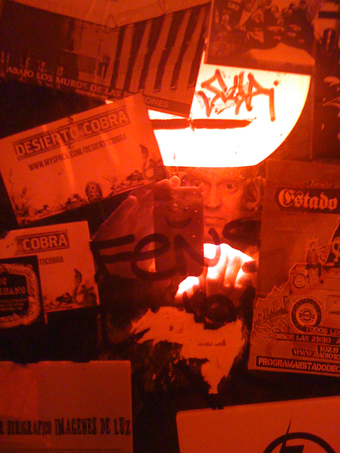 |
Tim Welfare in Bar Uno, Santiago, Chile |
a capital collaged
My family and I arrived in Santiago only five weeks after the devastating Chilean earthquake of February 2010. This is the second time I have lived for an extended period overseas and there is nothing like arriving in a new city and hearing its voice. In Beirut where I lived for three years, I was constantly bombarded with the sound of car horns, the call to prayer and the chatter of its people, allowing me some sort of understanding of where I was. On my arrival in Santiago however, I had none of these sensations. Everything seemed familiar: cars with revolving wheels and see-through windows; roads with seemingly set directions; pharmacies on every street corner; supermarkets selling most food items, beer included. But even with all of these familiarities, I still felt disoriented. Chile was much more complex than it seemed.
As a consequence of my limited Spanish, assisted by the translation app on my iPhone, visual language has become an important part of my communication. I watch re-run after re-run as Chile mourns the loss of television personality Felipe Camiroaga (and his facial hair) who died in a plane crash over Isla Robinson Crusoe. I have a quiet laugh to myself when walking past street vendors selling newspapers displaying back issues of the satirical political newspaper The Clinic whose crude, high-school homophobic collaged covers often depict President Pinera in compromising positions with religious and political leaders. I listen to taxi drivers humming or misinterpreting the lyrics of classic rock tunes on the radio. This same music is also piped through supermarket shopping malls and department stores, a perennial favourite of mine being The Smiths’ “Girlfriend in a Coma.” (This would be an interesting case study for a student in psychology at one of 1000 university campuses in Santiago—“Looking at the effects of misheard lyrics and western music in a retail setting.”)
The people of Santiago have always seen themselves differently from the rest of Latin America due in large part to the physical landscape as the Andes run the length of country. So rather than looking across its mountains and borders for influence, it looks elsewhere. One of my favourite appropriations is the large Hollywood-styled signs on the hills above Santiago telling you which suburb you are driving past.
Last year it seemed the city had adopted ‘Brand Australia' as a model. Curiously now, dated images of Australians with kangaroos as pets sit alongside a utopian landscape. Throughout the capital last summer, billboards for the clothing company doo australia portrayed young people in this fantasy landscape, presumably Australia. But since images produced by Chilean production companies for Norwegian hickory-smoked, spiral sliced ham products were shot in Patagonia, I'm sure this manufactured paradise of Australia is actually on the Chilean coast. Sure enough, many people are wearing the doo australia brand. Appropriated versions have also popped up: I even saw someone wearing a t-shirt with the "Aussie Aussie Aussie Oi Oi Oi" slogan emblazoned on it. So it would seem that Chileans have adopted Australia as their second country of choice.
for culture…
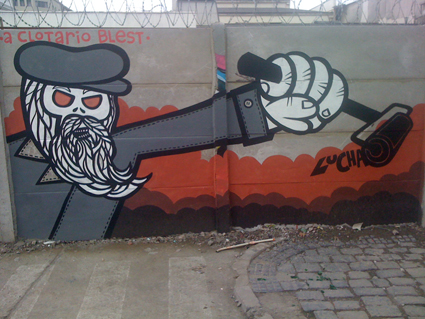 |
Street art, Santiago, Chile photo Tim Welfare |
Just down the road from the Memory Museum is M100 Cultural Centre. With a modern wooden façade the building has been integrated into the old cellars of the Dirección de Abastecimiento del Estado (State Offices). M100 is an integral element in Santiago's developing cultural landscape featuring a calendar of vibrant local and international art exhibitions, dance and theatre, films festivals and live events.
Currently showing is Coleccion Televisiva where 2,000 people from the local community were invited to each submit a video that had great personal resonance. Collaged together on a 15 x 6 metre wall across 11 screens, like a 17th century salon, the works present a range scenes from Chilean life such as Don Francisco (Chilean TV’s own Bert Newton, wig and all) hosting the annual ‘teleton’ intercut with footage from Bonanza, Beyblades (Japanese Manga), test patterns and news items from the military coup mixed with shots of the 1987’s Miss Chile/Universe winner and footage of the recent student protests played alongside rock band Queen’s video clip “Can’t Stop Me Now.” The grouping of these images offers more significance in their juxtaposition. This offers a truer sense of history than revealed in any textbook (where the winners write history). While the Pinochet military cracked down and arrested protestors in the streets, Bandstand-style programs were being screened in people’s living rooms with choreographed dancers performing to the latest hits from the US and the UK.
Also screening are Chilean Video art works as part the 2012 M100 program Video Concreta. These monthly shows have featured video programs from Chile, Colombia, Mexico, Argentina, Brasil and Australia. I recently curated boo australia, the lead out show for this series, the title derived from the streetwear clothing label mentioned above (see in the loop May 8).
Other cultural higlights include:
MAC (Museo de Arte Contemporaneo: a huge contemporary art museum with two locations operating in conjunction with the University de Chile.
Centro Cultural GAM: located in the old headquarters of the military which took control of the centre during the Pinochet period. In 2010 it returned to its original purpose as a cultural centre.
PLOP!: an art gallery and shop selling books and drawings by local illustrators.
La Chascona: the house, and now museum, of acclaimed Chilean writer Pablo Neruda.
Productant Mutante: Brainchild of Ervo Perez, this is one of the few organisations promoting electronic, rock and left-of-centre music from local contemporary and like-minded artists from the region, and also conducts regular workshops.
Santiago a Mil: international arts festival held annually in January.
for football…
Now there is culture. If you're in Santiago seeing a game of football is a must. South America is the newest powerhouse in the sport as European clubs are now buying even second-string players. Fanatical football fans chant, dance and drum as well as set off the occasional flare in the grandstands while those who live in the east of downtown sit at home in their private, locked condominiums watching the game on their 42-inch digital television sets. To be fair, the wealthy believe in a culture of sorts—consumer culture. Unfortunately the arts are not high on their agenda unless it is the art of driving their SUV's in all two or three lanes after a visit to the mall and then a Starbucks Cafe.
for street art…
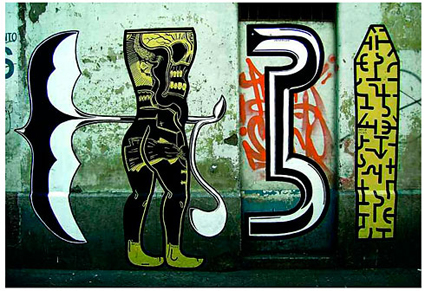 |
Street art by Basco Vazko, Santiago, Chile photo Tim Welfare |
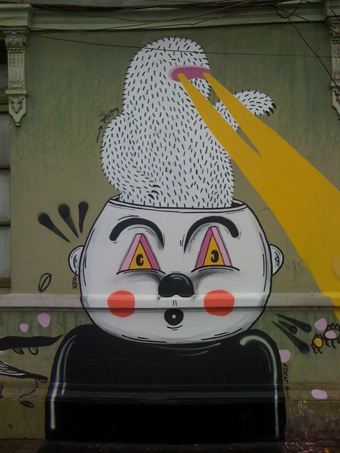 |
Street art, Bario Brasil, Santiago, Chile photo Tim Welfare |
for refreshment…
Bordering the city’s historic centre and separated by the Mapocho River are the two neighbourhoods of Bario Bellavista and Lastarria where there are the many great bars, restaurants, galleries and an expanding fashionable shopping area. I am probably not the best person to walk you through Santiago’s ever-growing classic and modern day cuisine, wine lists or fashion houses as I am more interested in something more shabby and real.
One of my favourite bars is Café 202 (Calle Estados Unidos, 202 Lastaria), a small intimate bar in a back street where there a few chairs and the owner plays a mix of strange music. I often meet friends here or have been known to swallow a large schoop (a three-litre glass) or two or three of Kross Golden Ale cerveza on my own.
Bar Uno is located across the river in Bellavista (Bombero Nuñez 1, esquina Bellavista) and is most comparable to the Evil Star in Sydney in its heyday. It’s roomed in an old house with real character and held together by the paint from the murals which cover the walls and the stickers from the many punk and awful rock bands who have played in this small and smoky venue. But once in a while you will see the odd gem such as post-punk post-rock bands Dizzlecciko or Animales Exóticos Desamparados. For me it is the people patronising Bar Uno who make it a unique adventure into the bowels (and other weary body parts) of Santiago’s nightlife.
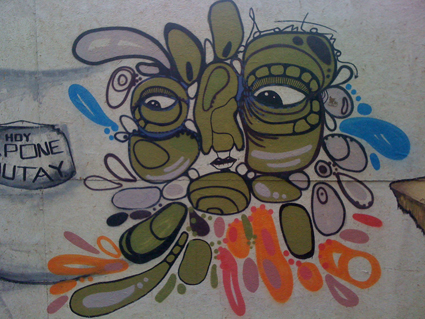 |
Street art, Santiago, Chile photo Tim Welfare |
links
The Clinic http://www.theclinic.cl/
Museo de la Memoria http://www.museodelamemoria.cl/
M100 http://www.m100.cl/
M100 Coleccion Televisiva http://www.artishock.cl/2012/09/coleccion-televisiva-la-cultura-de-las-pantallas-en-chile/
Boo Australia http://www.m100.cl/wp-content/uploads/2012/05/pressreleaseAustralia.pdf
MAC (Museo de Arte Contemporaneo) http://www.mac.uchile.cl/
MAVI (Museo de Artes Visuales) http://www.mavi.cl/
Centro Cultural GAM http://www.gam.cl/
PLOP! www.plopgaleria.com
La Chascona www.fundacionneruda.org
Productant Mutante www.productoramutante.org/
Santiago a Mil www.santiagoamil.cl
Chile Football http://www.anfp.cl/
Chile Estyle http://www.youtube.com/watch?v=jgS6q4ojs14
Basco Vazko http://bascovazko.com/
Brigada Ramona Parra http://www.graffiti.org/santiago/brp.html
Dizzlecciko http://www.youtube.com/watch?v=EP95lL1qoMA&feature=my_liked_videos&list=LL-99Azv-_oq7FjpaYvGKSzg
Animales Exóticos Desamparados http://www.youtube.com/watch?v=z7j-PxO41DQ&feature=my_liked_videos&list=LL-99Azv-_oq7FjpaYvGKSzg
Tim Welfare is a multimedia artist and curator who lives and works in Santiago Chile. Alongside directing and producing his own projects (/www.scratchmynose.net) he has been actively involved in curating and organizing a wide range of cultural projects presented in Sydney, Melbourne, New Jersey and London. While living in Beirut 2001-04, he curated the screening program middleasterntalentime for dlux media arts D>Art 06 festival, while in Santiago de Chile he has curated boo Australia for the M100 Cultural Centre.
related articles
inhabited by images and sounds
tim welfare talks with visiting lebanese video artist akram zaatari
RealTime issue #73 June-July 2006 pg. 19
digital experimentation: cultural reciprocity
david cranswick talks to realtime about d>art 06
RealTime issue #72 April-May 2006 pg. 26
in the loop – may 8
including boo australia
RealTime issue #108 April-May 2012 pg. web
© Tim Welfare; for permission to reproduce apply to [email protected]








 back
back